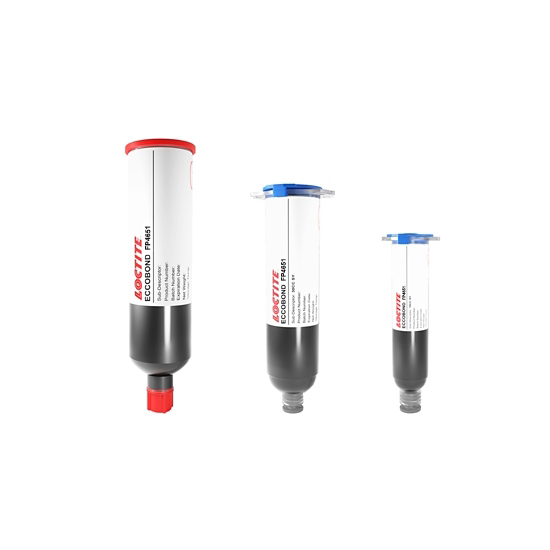LOCTITE ECCOBOND FP4651
- Excellent chemical resistance
- Low thermal expansion
- Alternative to FP4654
Product Description
LOCTITE® ECCOBOND FP4651 epoxy encapsulant features very low thermal expansion while retaining syringe dispense capabilities. Its low viscosity and 50 micron maximum particle size (Avg 7um) gives it improved handling properties over FP4650 for fine wire pitch and cavity-fill applications. It is based on FP4450 resin chemistry, therefore exhibiting excellent chemical resistance and thermal stability properties. With such a high filler rate(82% with 50um max filler size), low CTE and warpage it is essentially a liquid molding compound.
LOCTITE® ECCOBOND FP4651 is a top candidate for a drop in replacement of FP4654 that is slowly being phased out. Even though its viscosity is relatively higher, it is still well within the realms of jetting and dispensing so with the right amount of adjustments to surface and needle heat (and even without them) it should work great as an alternative solution.
Recommended Cure Schedule
- 1 hour @ 125°C plus
- 90 minutes @ 165°C
Technical Specifications
| General Properties | |
| Pot Life Pot Life Pot life is the amount of time it takes for the viscosity of a material to double (or quadruple for lower viscosity materials) in room temperature after a material is mixed. It is closely related to work life but it is not application dependent, less precise and more of a general indication of how fast a system is going to cure. | 48 hours |
| Specific Gravity Specific Gravity Specific gravity (SG) is the ratio of the density of a substance to the density of a reference substance; equivalently, it is the ratio of the mass of a substance to the mass of a reference substance for the same given volume. For liquids, the reference substance is almost always water (1), while for gases, it is air (1.18) at room temperature. Specific gravity is unitless. | 1.91 |
| Thermal Properties | |
| Glass Transition Temperature (Tg) Glass Transition Temperature (Tg) The glass transition temperature for organic adhesives is a temperature region where the polymers change from glassy and brittle to soft and rubbery. Increasing the temperature further continues the softening process as the viscosity drops too. Temperatures between the glass transition temperature and below the decomposition point of the adhesive are the best region for bonding. The glass-transition temperature Tg of a material characterizes the range of temperatures over which this glass transition occurs. | 150 °C |
| Electrical Properties | |
| Dielectric Strength Dielectric Strength Dielectric strength is measured in kV per mm and is calculated by the Breakdown voltage divided by the thickness of the tested material. Those two properties go hand in hand and while Breakdown voltage is always thickness dependent, dielectric strength is a general material property. As an example, the dielectric strength of Polyimide is 236 kV/mm. If we place 1mm of Polyimide between two electrodes, it will act as an insulator until the voltage between the electrodes reaches 236 kV. At this point it will start acting as a good conductor, causing sparks, potential punctures and current flow. | 49.8 kV/mm |
| Physical Properties | |
| Viscosity Viscosity Viscosity is a measurement of a fluid’s resistance to flow. Viscosity is commonly measured in centiPoise (cP). One cP is defined as the viscosity of water and all other viscosities are derived from this base. MPa is another common unit with a 1:1 conversion to cP. A product like honey would have a much higher viscosity -around 10,000 cPs- compared to water. As a result, honey would flow much slower out of a tipped glass than water would. The viscosity of a material can be decreased with an increase in temperature in order to better suit an application | 130,000 mPa.s |
Additional Information
Why are there some gelling differences between FP4651 and FP4654?
Looking at the FP 4651 un-cured properties vs "good old FP 4654" we see some differences which could be related to the "gelling" of FP 4651"
- FP 4651 has a shorter work life at 25°C (time to double viscosity) than FP 4654 (2 vs 3 days)
- FP 4651 has a shorter GEL time at 121°C than FP 4654 (9 vs 11 minutes)
- FP 4651 has a higher silica filler loading (82 vs 80%) and consequently higher base viscosity than FP 4654
This means FP 4651 can have a certain (and smaller) viscosity range for your application and the equipment than FP 4654. A work life of 2 days of FP 4651 still looks nice on paper, but we assume that doubling of such a high(er) viscosity would not fit some well-defined and tight processes.
Heating up the needle to 40C can help to reduce the viscosity, but will also speed up the gelling.



